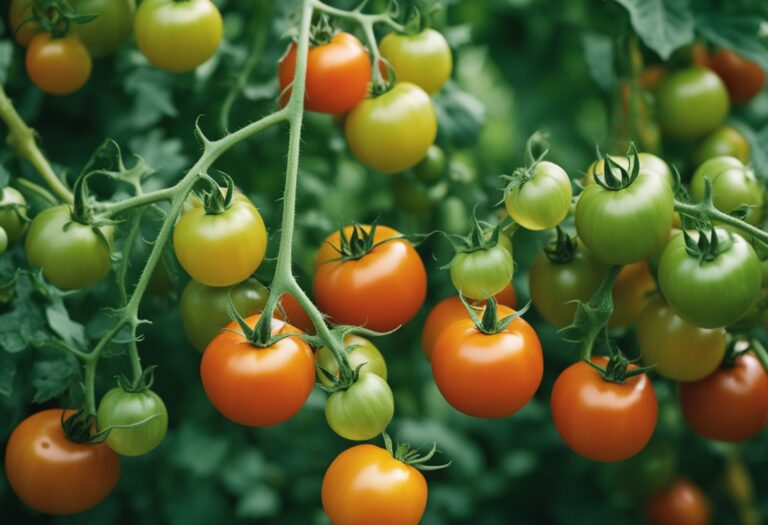Will Frost Kill Tomato Plants? Understanding the Impact of Cold Temperatures on Tomato Growth
If you are a tomato grower, you may wonder if frost will kill tomato plants. The answer is that it depends on the severity of the frost. Tomato plants can withstand light frost, but a hard frost can kill them. Understanding the effects of frost on tomato plants and how to prevent and recover from frost damage can help you protect your plants and extend your growing season.
Frost is the formation of ice crystals on plants caused by freezing temperatures. When ice crystals form inside plant cells, they can damage the cell walls and cause the plant to wilt, turn black, and die.
Tomato plants are particularly vulnerable to frost damage because they are warm-weather plants that are sensitive to cold temperatures. However, with proper care and protection, you can minimize the risk of frost damage to your tomato plants.
Key Takeaways
- Frost can kill tomato plants if it is severe enough.
- Understanding the effects of frost on tomato plants is important for protecting your plants.
- Preventing and recovering from frost damage can help you extend your growing season.
Will Frost Kill Tomato Plants?
Tomatoes are generally warm-season crops and are sensitive to cold temperatures. Even a light frost can damage both the foliage and the fruit of tomato plants. In addition, many areas of the US can experience an early fall frost that is followed by several weeks of warm weather, which can be detrimental to the health of tomato plants.
When temperatures drop below 32°F (0°C), the water inside the tomato plant’s cells freezes and expands, causing the cell walls to burst. This can lead to severe damage to the plant’s tissues, which can result in stunted growth, wilted leaves, and even death.
However, the extent of the damage caused by frost depends on several factors, such as the duration and intensity of the frost, the stage of growth of the tomato plant, and the variety of tomato. Some tomato varieties are more cold-tolerant than others and can survive light frosts.
To protect your tomato plants from frost, you can take the following measures:
- Cover your tomato plants with blankets, tarps, or other protective coverings to keep them warm. Make sure to remove the coverings during the day to allow sunlight and air to reach the plants.
- Water your tomato plants before the frost to help them retain heat. Wet soil retains more heat than dry soil, which can help protect the roots of the plant.
- Use frost cloth or row covers to protect your tomato plants. These materials allow air and sunlight to pass through while providing a layer of insulation to keep the plants warm.
- Plant your tomato plants in raised beds or containers, which can help protect the roots from frost damage.
If your tomato plants have been damaged by frost, you can take the following steps to help them recover:
- Prune the damaged parts of the plant to prevent disease and promote new growth.
- Water the plant thoroughly to help it recover from the stress of the frost.
- Apply a fertilizer high in phosphorus to help the plant recover and promote new growth.
Understanding Frost and Its Effects
When the temperature drops below freezing, frost can occur, and it can damage your tomato plants. Understanding how frost affects your plants can help you take the necessary steps to protect them.
Frost damages plants by causing ice crystals to form on the plant’s cells, which can rupture and damage the cell walls. This damage can lead to wilting, browning, and even death of the plant.
There are two types of frost that can damage tomato plants: radiation frost and advection frost. Radiation frost occurs on clear, calm nights when heat is radiated from the ground, causing the air temperature to drop below freezing. Advection frost occurs when cold air moves into an area, causing the temperature to drop rapidly.
When frost occurs, the damage to your tomato plants depends on several factors, including the duration and severity of the frost, the age and health of the plant, and the location of the plant.
Here are some effects of frost on tomato plants:
- The leaves and stems of the plant may become wilted or limp.
- The fruit may become soft or mushy.
- The leaves and stems may turn black or brown.
- The plant may die if the frost is severe enough.
It’s important to note that not all tomato plants are equally susceptible to frost damage. Some varieties are more cold-tolerant than others, and older, established plants are generally more resistant to frost damage than young plants.
In the next section, we’ll discuss how to protect your tomato plants from frost damage.
Preventing Frost Damage to Tomato Plants
If you live in an area with cold weather, your tomato plants may be at risk of frost damage. Fortunately, there are several ways to protect your tomato plants from the cold.
Plant Tomatoes at the Right Time
To avoid frost damage, it is important to plant your tomatoes at the right time. Wait until after the last frost date in your area before planting. You can find the last frost date for your area by checking with your local extension office or using an online tool.
Cover Your Tomato Plants
One way to protect your tomato plants from frost is to cover them. Use blankets, tarps, or other materials to cover the plants at night when temperatures drop. Make sure the cover is secure and covers the entire plant, including the top and sides.
Use Mulch
Mulch can help protect your tomato plants from frost by keeping the soil warm. Apply a layer of mulch around the base of the plant to help retain heat in the soil. Straw, leaves, or grass clippings can all be used as mulch.
Water Your Tomato Plants
Watering your tomato plants before a frost can help protect them. Wet soil holds heat better than dry soil, so watering your plants can help keep them warm. Water early in the day so the plants have time to dry before nightfall.
Use Row Covers
Row covers are a type of fabric that can be used to protect plants from frost. Place the covers over your tomato plants before a frost to help keep them warm. Row covers can be left in place for several weeks, allowing you to extend your growing season.
Build a Cold Frame
A cold frame is a type of mini greenhouse that can be used to protect plants from frost. You can build a cold frame using materials like PVC pipe and plastic sheeting. Place your tomato plants inside the cold frame and cover it at night to protect them from the cold.
By following these tips, you can protect your tomato plants from frost damage and ensure a healthy harvest. Remember to always check the weather forecast and take action to protect your plants when necessary.
Protecting Tomato Plants from Frost
If you live in an area that experiences frost, protecting your tomato plants is essential to ensure a healthy harvest. Here are some tips to help you protect your tomato plants from frost:
1. Cover your plants
Covering your tomato plants is one of the most effective ways to protect them from frost. You can use blankets, tarps, or frost covers to cover your plants. Make sure to secure the cover to the ground with ground staples or tent pegs. Remove the cover the next morning so the tomato plants can bask in the sunshine.
2. Use a plastic tarp
On chillier nights, layering a plastic sheet on top of the fabric materials will provide a bit more insulation against the cold. The plastic tarp will help trap heat and protect your plants from frost. Make sure to remove the tarp the next morning to allow your plants to receive sunlight.
3. Choose cold-tolerant varieties
Another way to beat the cold is to choose tomato varieties that have been bred to be more cold-tolerant and to set fruit in cooler temperatures below 55 degrees F. These varieties typically also mature earlier. Early-season varieties mature in 52 to 70 days and mid-season tomatoes in around 70 to 80 days.
4. Use tomato cages or garden stakes
A tomato cage (wood or metal) or sturdy garden stakes should be used to protect your tomato and pepper plants against frost. The tomato cages or garden stakes will act as a structure for your plants, and bubble wrap will wrap around it to keep it safe.
5. Water your plants
Water your plants before the frost sets in. The water will help insulate the roots and protect them from the cold.
6. Check the weather forecast
Keep an eye on the weather forecast and plan ahead. If frost is expected, cover your plants the night before to protect them from the cold.
By following these tips, you can protect your tomato plants from frost and ensure a healthy harvest.
Recovering Tomato Plants After Frost
If your tomato plants have been affected by frost, there are a few steps you can take to help them recover. Here are some tips to help you revive your frost-damaged tomato plants:
1. Assess the Damage
Before taking any action, it’s important to assess the damage to your tomato plants. Frost damage can manifest in different ways, such as wilted leaves, blackened stems, or discolored fruit. If the damage is severe, it may be difficult for the plant to recover. However, if the damage is minimal, the plant may be able to bounce back with some care and attention.
2. Prune the Damaged Parts
Once you’ve assessed the damage, it’s time to prune the affected parts of the plant. Use a sharp pair of scissors or pruning shears to remove any wilted, blackened, or damaged leaves and stems. This will help the plant focus its energy on the healthy parts and promote new growth.
3. Provide Adequate Water and Nutrients
Frost damage can cause stress to the plant, which can affect its ability to absorb water and nutrients. To help your tomato plants recover, make sure they are getting enough water and nutrients. Water the plants deeply and regularly, and consider adding some fertilizer or compost to the soil to give them a boost.
4. Cover the Plants
If there’s a chance of frost in the forecast, it’s important to protect your tomato plants. Cover them with blankets, tarps, or other protective materials to keep them warm and shield them from the cold. Make sure the covers are securely fastened and don’t touch the plants directly, as this can cause damage.
5. Bring Your Plants Inside
If the temperature drops below freezing, it’s best to bring your tomato plants inside to protect them from the cold. Place them in a sunny window or under grow lights, and make sure they are getting enough water and nutrients. This will give them the best chance of surviving the winter and producing fruit in the spring.
By following these tips, you can help your tomato plants recover from frost damage and thrive. Remember to keep an eye on the plants and adjust your care as needed. With a little patience and TLC, your tomato plants can bounce back from even the most severe frost damage.
Frequently Asked Questions
How can I protect my tomato plants from frost?
There are several ways to protect your tomato plants from frost. One way is to cover them with blankets, tarps, or other materials that can trap heat. You can also use plastic covers or cloths specifically designed for frost protection. Make sure to secure the coverings tightly to prevent them from blowing away in the wind. Additionally, you can use mulch to insulate the soil and keep the roots warm.
What temperature is too low for tomato plants?
Tomato plants are sensitive to cold temperatures and can be damaged or killed by frost. The ideal temperature range for tomato plants is between 60 and 85 degrees Fahrenheit. Temperatures below 55 degrees Fahrenheit can slow down growth and cause the leaves to turn yellow. When the temperature drops below 32 degrees Fahrenheit, tomato plants will freeze and die.
What are some homemade covers for tomato plants?
You can make your own covers for tomato plants using materials you may already have at home. One option is to use old blankets or sheets to cover the plants. You can also use plastic bags or shower curtains to create a makeshift cover. Another option is to use cardboard boxes or milk jugs with the bottoms cut out to create a protective dome over the plants.
Can tomato plants recover from frost damage?
It depends on the severity of the frost damage. If the plants are only slightly damaged, they may recover over time with proper care. Remove any dead or damaged leaves and stems, and make sure to keep the soil moist. However, if the plants are severely damaged or have been completely frozen, they may not recover and will need to be replaced.
Should I cover my tomato plants for frost?
Yes, covering your tomato plants is a good way to protect them from frost. Make sure to cover the plants before the temperature drops and remove the coverings during the day to allow for sunlight and air circulation. Be sure to secure the coverings tightly to prevent them from blowing away in the wind.
What should I do with tomatoes damaged by frost?
If your tomatoes have been damaged by frost, you can still use them for cooking or making sauces. However, the quality and flavor may be affected. If the tomatoes are completely frozen, they will need to be discarded. To prevent frost damage in the future, make sure to cover your plants or bring them indoors during cold weather.



